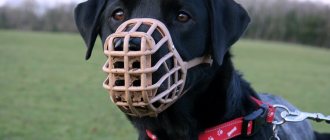Causes of barking
Dogs bark for various reasons, they can:
- give signals to another animal;
- sound the alarm;
- play or provoke play;
- worry about the current moment;
- demand a reaction;
- do this out of fear and the need to drive away another animal or object;
- yapping just like that.
Sometimes the cause of barking may involve a combination of the above.
Our goal is not to make the dog stop barking altogether (especially when dog noise is an alarm signal). But it would be great if pets stopped making a fuss when asked or did not create a fuss for no apparent reason.
Some dogs bark at the slightest noise, disturbance or movement.
Certain breeds have a genetic tendency to bark frequently.
Also, the owner often reinforces this behavior. For example, when he shouts at a barking dog, the dog thinks that the owner is joining her and begins to bark with even greater force.
On the other hand, if the owner gives the command to be silent in a soft or affectionate manner, the dog may perceive that he enjoys barking and this is a reason to receive praise every time.
And, accordingly, it will make noise every time to receive love.
The dog is bored
A bored dog can be compared to a boiling kettle: when the pressure is too high, it starts to whistle.
So a dog, who has nowhere to expend his energy, begins to bark, chew objects, scratch or do something else that will bring him release. In this case, barking is usually monotonous, sometimes interrupted by howling. The way out of the situation is to find something to do for the animal, tire it out on a walk and leave dog toys and teethers for the puppies.
How to establish control?
Depending on the reason why your dog is making noise, you can use different approaches to calm it down or prevent it from barking for no reason. a lot to do with the confidence the owner displays in being able to handle different situations.
To gain this confidence, an owner must understand their dog and the situations that trigger barking.
With this understanding, the owner demonstrates calm, confident leadership and is in control of the situation.
The dog responds with calmness because it can trust the leader to take responsibility. From the very beginning of a relationship, you need to create a foundation that provides trust and inner confidence.
Remember that barking is one of the ways a dog communicates with us , so there is no need to try to get rid of this form of communication, but it should be controlled as necessary.
The ability to read your pet's signals is essential to building relationships.
How to silence?
There are several ways to silence an animal. Actions can be very diverse, choose those in which you can be consistent - this increases the chance of success.
Cover your mouth
If a dog barks and lunges at other people and animals, then you, as a careful and “affectionate” leader, should cover its mouth, showing that such behavior is unacceptable.
You have an advantage, use it. Put on a leash and, if the dog begins to behave inappropriately, tighten it, close its mouth and force it to sit.
Next , move, attracting your pet's attention to you - this way you distract her from the objects she is barking at.
This way the owner receives attention that builds respect and avoids conflict situations between the dog and the outside world.
Bring a gift
Another way to keep your dog's mouth closed is to encourage him to bring a "gift" to you, a guest, or someone in your home. You can teach her to enjoy carrying objects.
Dogs who love prey will often pick up a toy and carry it around with them just to express pleasure.
Naturally, animals cannot make noise and hold a toy in their teeth at the same time. But be careful about giving a toy while barking, because your pet may accept the toy as a reward for barking.
Bark on command
Another approach that may work is to teach your dog to bark on command and then tell him to be quiet.
If you practice treats or verbal praise, wait a few seconds after your dog finishes barking before rewarding him. You don't want your animal to think she is being rewarded for barking when in fact she is being rewarded for being silent.
To initially encourage voting, you can ask someone to ring the doorbell. Have your dog on a leash during the exercise so you can distract and stop the barking with a gentle tug of the leash.
To make the feedback even better, let your dog know that he can bark at the doorbell, but then he should shut up and go to his place at the door, where he can watch whoever is at the door, allowing guests to enter.
When the animal begins to bark, the owner must say “Quiet” and wait until the barking stops. When the door opens, the dog should sit and watch silently on the command “Place.”
One word “Voice” should encourage the animal to bark again. Thus, by teaching the commands “Voice”, “Quiet” and “Place”, you get a trained animal under your control .
Such a pet is able to repel danger and protect the home.
Abstraction
Some dogs need a break and distraction to stop barking. In other words, something must prevent the animal from concentrating on barking.
Sometimes a verbal command is not enough. In this case, the interrupter may be another noise, such as an instrument that produces a high-frequency sound. This is an unpleasant sound for the dog, it silences him.
Other things that can help distract your attention are a bag of beans, a heavy rattling chain, or a jar of pebbles or coins. It works like this: the dog barks, you throw a noisy object in front of it, but without it noticing. Act as if the object literally landed from heaven. This way the animal will develop a logical chain: if you bark for no reason, something appears out of nowhere, possibly dangerous.
Be a leader
Earlier it was said not only about the owner’s ability as a leader to cope with difficult situations, but also about the dog’s confidence in his actions. It comes from training, spending time together, setting boundaries, and appreciating behavior that pleases the owner.
Controlled walks and games, accompanied by the commands “sit”, “lie”, “near”, turn the pet into a friend who feels attention and care and sees no reason to make noise without a reason. This creates an atmosphere of trust and confidence that allows the dog to know when it can and should bark , as well as when it can be calm.
Think carefully before you ignore the noise of a dog. It’s easier to reconfigure the animal’s behavior in the right direction than to wait for the problem to go away on its own.
Additionally, check out this short video on how to stop a dog from barking at everyone, other dogs and people:
Excited barking at other dogs
We looked at how you should behave if your dog barks when you come home or to guests. And sometimes it happens that a dog barks excitedly at its relatives. How to stop a dog from barking in such cases - or rather, teach it to perceive other dogs more calmly?
Let us turn to the book by Tyurid Rugos “Barking - what are dogs talking about?”:
“This type of barking is most often misinterpreted. Seeing a dog barking at its relatives, people believe that such a dog is aggressive and punish it. It must be recalled that barking and aggression are not the same thing. People have known this since ancient times. There is a saying from Viking times: “A barking dog never bites.” If such a dog is cornered and threatened, it may bite. In such a situation, anyone will bite.
Our dogs are more interested in other dogs than anything else. This interest manifests itself at a very early age. At the sight of its relatives, the puppy becomes excited, sometimes even begins to bark. And if the normal reaction to other dogs is disrupted, then over time the excited barking becomes hysterical. There are two reasons for this violation:
1. For some time, the dog played too much or too uncontrollably with his relatives, and now, when he sees them, he again becomes overexcited, his stress level increases, and he begins to bark;
2. The dog has never met other dogs, so when he sees a relative, he begins to get hysterical.
Both reasons lead to rather unpleasant consequences.
Both puppies and young dogs need to spend a lot of time around other dogs. At the same time, they develop social communication skills. But the development of these skills does not occur only through play, since when playing, dogs become excited and are unable to learn the subtle techniques of communication. They must be given the opportunity to simply be together. Even a short act of greeting on the street can be helpful.
In other words, for normal development of communication skills, puppies need several types of social contacts with other dogs. This way, they won't bark hysterically at the sight of other dogs, causing problems for both dogs and people.
Here are a few methods to help solve this problem:
- from time to time, give the puppy the opportunity to play a little with other puppies of about the same size and age (or with adult dogs who willingly play with puppies and do not offend them). This game should not last too long, 8-10 minutes is enough, and sometimes less. It must be stopped before it becomes unbridled or, better yet, escalates into bickering.
— when the dogs are past puppyhood and can go on long walks with them, it is best to invite other owners with their dogs on such walks. It may be necessary to keep the dogs on leashes at first until they get used to each other, and then, if possible, let them go. Walking together is a good opportunity to be together, to experience the same sensations - smells, sounds and everything that arouses common interest, especially since the use of the senses is probably the most important thing when a puppy is growing up when comprehending his surroundings peace.
This is how the relationship between dogs becomes trusting and calm.
— a good method is also training, which consists of sitting with the dog at home by the window or on the street and calmly watching other dogs from afar (we often did this with my first dog, the American cocker Coney).
— meet older, friendly dogs. Puppies need to know some relatives who would act as role models. This gives them the opportunity to see what they can become when they grow up. If puppies interact with other dogs only during play, they get used to the fact that social communication consists only of play. Thus, they will not acquire the subtle social skills necessary for self-control and communication with their relatives.
In humans, we see the same pattern: children need an adult as a role model from whom they can learn the basics of life. If children are left to their own devices, they begin to have problems.
Raising a puppy
The sooner the owner starts training and raising the puppy, the easier it will be to communicate with the dog in the future not only for him, but for all family members.
Please pay attention to the following points:
- The puppy should accept your commands from one word. As for barking, you can prohibit it using the commands “quiet” or “fu” (some prefer the long “no”).
- It is believed that positive reinforcement is the most effective way that allows the owner to achieve his goals. How it works: If the command is executed correctly, the dog receives a reward in the form of a treat.
If the dog becomes silent, it should be rewarded. This will gradually form in her the understanding that obeying the owner is good and pleasant.
Animals need to be punished correctly. In the case of a barking puppy, you can flick your fingers on the nose several times while repeating “ugh” (or “no”). The use of brute physical force is pointless, since by achieving the dog’s submission, intimidating it, you can get not only obedience, but also mental disorders of the animal and, as a consequence, its possible inappropriate behavior in the future.
How to stop a dog from barking at other dogs: 10 tips and tricks
The dog must behave well at home and on walks, treat people adequately and react calmly to other animals, without showing aggression without a reason. The character and behavior of our little brothers largely depends on proper upbringing and systematic training. We will look at how to stop a dog from barking at other dogs. We will give recommendations and advice from dog handlers that will help in solving this problem.
Effective ways to train dogs
To date, dog experts have developed several effective ways to stop a dog from barking at its relatives. Let's consider each of them in order.
Method No. 1. Command “Come to me!”
- Regardless of age, teach your dog the “Come to me!” command. When the first successes appear, be sure to praise your pet by treating him with treats.
- As soon as your pet attempts to bark, immediately give the command. Do this without aggression, constantly rewarding the dog for submission. If the dog ignores your orders, indicate your position.
- You must convey to your pet that such actions are not acceptable. For many animals, a stern look or reprimand is enough. These manipulations will make the dog feel guilty.
- Frequent training practice will help the animal understand in which situations it is rewarded and in which it is reprimanded.
Method No. 2. Touching your ears
- The next time your dog barks, touch its ears. This move will allow the pet to calm down. If the animal does not respond to touch, lightly squeeze the shells of its ears with your thumb and forefinger.
- Try to calm the dog down by stroking the head, this way the pet feels supported by you and quickly calms down.
Method number 3. Nutritional supplements
- Contact a specialized pet store (veterinary pharmacy) and ask for nutritional supplements with a calming effect based on natural ingredients.
- Such preparations are available in solid or liquid form. The substance is dripped into the pet's mouth, thereby weaning large breed dogs from barking for no reason.
- The medicine calms the animal without harming its health. This method is used if you do not have enough time to fully train your pet.
Method number 4. Collar with essential oil
- If all your efforts to raise your pet are in vain, use a special collar soaked in soothing essential oils. You can buy it at any pet store.
- The collar's action is aimed at suppressing the dog's overexcitement. The accessory will also help stop your pet from howling frequently. The difference between this attribute and the electric one is that the animal does not experience fear or stress.
Method No. 5. Eliminating irritants
- Many pets often respond to a telephone or doorbell. Turn off the signal or turn the volume down. Such factors have a strong psychological impact on the dog, resulting in barking.
- If your pet begins to vocalize when walking completely freely, stop frequently letting the dog off the leash. Identify the main reasons for the animal's barking.
- When the irritation factor is established, try to avoid such situations, while weaning and training the dog.
how to stop your dog from pulling on the leash when walking
Reasons for dogs barking on the street
How does your dog treat other animals? Perhaps the pet happily runs up and sniffs other dogs, wanting to get to know each other, or, on the contrary, barks at everyone who walks on four legs? If you constantly keep your dog on a leash and try to notice other animals before it, such walks are not a joy. Dogs should be able to walk without a leash, of course, under your strict control.
But if a dog constantly barks at other dogs and reacts inappropriately to his relatives, he can provoke a fight. Aggressiveness, depending on the size of the animal, will harm its health or other dogs. And dog breeders will not be delighted with such manners, especially if you have a large or medium breed dog.
If a dog barks at other animals or people for no reason, it can lead to serious consequences. A dog that barks hysterically is difficult to control . To avoid problems, let’s find out the reasons for this behavior in a puppy or adult dog.
Important! Barking is not a manifestation of aggression towards dogs, animals, or humans. This is a canine language characteristic of all breeds and ages, a communicative means through which the dog expresses its emotions, mood, and communicates with its owner and its relatives.
Causes of dog barking:
- fear, aggression, fright, irritation;
- attraction of attention, lack of communication, separation;
- strong emotional arousal;
- danger warning;
- call for games;
- improper socialization, errors in education.
Dogs bark to defend their territory, warning other animals about a possible conflict with a loud, intermittent, assertive bark.
Barking is a warning signal and a sign for other animals if the dog senses danger.
- An inappropriate reaction to other dogs, accompanied by barking, often signals that the dog is afraid, very scared or feeling aggressive. Barking is accompanied by gestures of submission. The dog licks its lips, stretches its neck forward, and hides behind its owner.
- Barking is a means of attracting attention if the dog is bored or calls for play. It is known that our little brothers are not only inquisitive, but also build their relationships and determine their social position through play. If the pet wants to play with another dog, the barking will be short and intermittent. The dog energetically wags its tail, sits down on its front paws, raising its croup, or brings sticks and toys to its fellow dog.
- There is a category of dogs that do not get along with their relatives and assert themselves through loud, menacing barking, which is accompanied by growling. If the dog bares its teeth, wags its tail, or takes on intimidating poses, be prepared for the fact that it may attack the dog . Therefore, carefully monitor his behavior and put him on a leash.
- Dogs often bark at other animals while behind a fence. The dog does not so much protect its territory, but experiences irritation, uncertainty and even fear. A barrier, the inability to overcome an obstacle provokes the release of adrenaline. The pet becomes overexcited, barking hysterically loudly. Aggression is directed at everything outside the fence.
Causes of puppy barking
It is possible that your dog barks at his relatives if, as a puppy, he was scared or bitten by another dog. A puppy who has suffered emotional trauma may experience intense fear of other animals and dogs throughout its life. Improper socialization and training can also lead to barking for no reason. Perhaps the dog spent little time in the company of his relatives and his communication and social skills are poorly developed.
Constant walking on a leash can provoke such behavior. The dog is deprived of normal communication with his relatives, emotional release and by barking attracts their attention.
It is possible that barking on the street may be caused by improper upbringing of the puppy. Remember, maybe you, trying to develop confidence in your pet, poisoned him against other animals? Such mistakes are often made by breeders of fighting breeds, not understanding how this can turn out in the future.
If your dog barks only at unfamiliar dogs or certain breeds, it is possible that our little brothers have developed an antipathy, which can be caused by various factors. Animals might not share territory or toys. Perhaps there was a conflict between the dogs before, and the dog remembered his offender. A dog may bark at its relatives because it is spoiled. The owner simply did not attach any importance to the fact that his dog barks at other dogs and did not immediately wean him off the bad habit.
How to stop an adult dog from barking at other dogs
There is no doubt that proper manners should be taught to pets at an early age. But if the moment of education was missed or you got an adult dog that is not obedient, act firmly, but consistently. In the case of a completely uncontrollable pet, entrust its training to a dog handler.
Advice! A grown puppy or adult dog can wear a strict collar. It is better to use one, but strong stimulus than to constantly jerk the dog with a regular collar.
If your dog barks at dogs on the street or reacts angrily to other animals, do not let your pet off the leash. As soon as the dog craps on his fellow dog, in a stern tone give the command “No”, “Fu” and pull the leash firmly. Lightly spank your pet with a twig or rolled up newspaper.
Repeat similar actions until the dog begins to calmly perceive his relatives. If the neighbor’s dog or other dogs in the walking area are barking and you know that your dog will “voice” if he is not on a leash, call him to you, turn your attention away from the source of irritation.
If on a leash, jerk the leash sharply and give a forbidden command. The main goal is to teach the dog to respond to your commands, and not to outside stimuli . Do not allow the dog to react and bark at dogs behind the fence. Walk along houses with your pet on a leash. As soon as the dog learns to respond adequately to its relatives, praise and encourage it in a gentle tone.
Continue “fence” training until you achieve results. Correct behavior with intonation, leash, strict collar, commands. After obedience and a normal reaction, you can loosen the leash or remove the “stringer” from the dog.
If the dog reacts specifically to the same dog, try not to overlap in walking areas. Walk at other times or in other places. When teaching an adult dog proper manners, act consistently, but achieve your goal. A ban is a ban, so no concessions.
Why does the dog bark
The tendency to bark is determined genetically and by environmental influences. Such a habit may appear as a consequence of certain events. For example, a dog reflexively barked one day at the sight of a person suddenly appearing and noticed that he stopped or jumped back. Now the dog knows that barking loudly can stop or force a suspect to retreat. Another example is when a pet noticed that barking caused the owner to pay attention to it, pet it, or talk to it. Of course, now, when he wants to attract the owner’s attention to himself, he will bark.
To properly diagnose the problem, you need to find out the circumstances that cause the dog to bark.
Carefully monitor the animal’s behavior and answer simple questions about the appearance of barking:
- When does this happen - at night, when he is alone, during a thunderstorm or other sudden loud noises?
- Where - on the street, while walking, in the car, at home?
- When did the barking start - from puppyhood, after moving, after returning from vacation?
- Is barking associated with the presence or absence of a person?
- Does the dog react by barking when looking at something specific - a person, thing, animal? Doesn't matter?
Important information is also how the owner reacts to barking and how the animal behaves after this. All dogs are very different, not only in appearance, but also in their character and temperament. It is difficult to fit their behavior into general stereotypes. But in order to keep the situation with your dog’s noisy behavior under control, you need to know the most common causes of barking. These include:
- Getting Attention: “Can anyone take care of me?”
- Fight for territory: “Run, this is my place!”
- Boredom: “I have nothing to do. Bark or “sing”!
- Feeling of fear: “I am afraid. Please move as far away as possible!
- Showing joy: “Do I need a reason? I'm just having a great time! "
- Longing: “Don’t leave me, come back soon!”
Each of the listed situations why a dog barks presents a separate problem and the barking sounds different. But it is possible that the origins lie somewhere deeper, causing increased stress that manifests itself in behavior that corresponds to some of these situations.
What not to do: basic mistakes and tips from dog handlers
To ensure that your pet is well-mannered and obedient, properly organize the educational process. Pay attention to your pet's socialization. After the end of quarantine, do not walk with your puppy without a leash in public walking areas. The dog must get used to the street, new smells and sounds.
- Never pit dogs against each other, even as a joke. Feeling its advantage, the pet will suppress its relatives, which can end disastrously if the dog does not calculate its strength.
- Never hit, scream or use physical violence against a dog using a leash or other available means. Rough treatment will give the opposite reaction, develop anger, provoke aggression. If the dog is wrong, spank him lightly with a rolled-up newspaper or a thin twig, but not with your hand. Impact should be minimal.
- If your puppy is shy, don't focus his attention on other dogs. Get used to communicating with your relatives gradually. The baby should be kept company by calm and friendly dogs. Hold representatives of small breeds near dog walking areas.
- Some owners make the mistake of starting to walk a small puppy with older dogs. Males often attack puppies and young males. Fights break out between dogs.
- Don't encourage your puppy to yelp at other animals. The dog will grow up and it will not be easy to wean him from this habit. Breeders of decorative breeds also make a similar mistake, allowing their pets to crap on large and adult dogs. Annoying, hysterical barking for no reason will cause discontent and aggression even in a balanced dog, and your pet may suffer.
- Do not encourage overly emotional games that provoke increased excitement. If your dog starts barking while playing, calm him down and put him on a leash.
- You can teach a dog to treat its relatives adequately at almost any age. Act consistently but persistently. The dog must understand and complete the assigned tasks.
Sources:
https://tvoidrug.com/training/otuchit-layat.html https://talkingdogs.ru/kak-vospityvat-shhenka/vozbuzhdennyj-laj-na-drugix-sobak/ https://vashipitomcy.ru/publ/sobaki /soderzhanie_i_ukhod/kak_otuchit_sobaku_lajat_na_drugikh_sobak_10_sovetov_i_rekomendacij/29-1-0-2441
What should you do if your dog throws itself at other dogs?
The owner's first desire is to pull the dog back. The person begins to tighten the leash, pull the dog towards him, and sometimes shouts to other owners, “Move away, my dog is aggressive,” when the dog begins to choke on barking.
And then this situation happens: the owner takes his dog, walks around other dogs and looks at them intensely. The dog begins to get even more excited.
It's a vicious circle. If the owner behaves this way, the dog will lunge and bark more and more. Why?
Firstly, the owner gets his own dog. When you see another dog and pull on the leash, you are showing your dog that this dog makes you feel uncomfortable, you are afraid of it, you want to attack it, and the dog is supporting you. He offers you the behavior of “let’s attack together” or “let’s be afraid together” and begins to throw.
Until you relax yourself, nothing will change further. You may ask, “but the dog is throwing, what should I do with it?”
The owner is the basis . If you can change your behavior, you can then change the dog's behavior. After all, a dog always follows the owner’s fortune. She goes where the person leads her.
A very common occurrence in training is that I pick up a dog and it calms down because I am calm inside. I know that I can handle any dog, I know that I can hold it, guide it, make the dog hear me. The owner is not sure about this, so he is tense and tense.
That's why:
- First, you need to calm down and understand that this situation is fixable. You need to start with yourself.
- Second, let's move on to the dog. Let's understand why a dog barks?
The first thing, as we have discussed, is the owner’s incorrect behavior.
Second, the leash is too short. The dog sees another dog and begins to behave aggressively or become afraid. There is a very fine line here, the dog is really afraid or aggressive. Moving away, the dog tucks its tail, curls its lower back, it is afraid, so it throws itself, saying “don’t come near me.” Sometimes a dog barks due to excitement. And sometimes the dog is aggressive.
In any case, this shows that it is not the person who decides how to behave in this situation, but the dog. Your task is to teach the dog different behavior in this situation, that is, to take control of the situation. But do not punish the dog for such behavior.
Your task is not to punish the dog for incorrect behavior, but to transform it into a different form. Previously, the dog, seeing other dogs, wanted to rush at other dogs, and your task is to switch attention to yourself.
The next thing, when the dog looks at you, you include work that is useful for it, or in commands, or in some tasks for it and switch the attention from that dog to yourself. You relieve excitement, and secondly, you show with your condition that you are actually calm.
This way you start working from a distance where the dog can control himself step by step every day, moving closer and closer to other dogs.
What if you don't restrain your dog? Or do you encounter some dogs that suddenly come around the corner? A halter comes to your aid, you put a halter on your dog, and as soon as the dog tries to pull, its muzzle turns towards you.
These are easy moments to solve such a problem as aggression on a leash. There are, of course, even more complex, confusing cases. For 50-60% of owners, what I told you is enough for the dog to stop throwing.
Sources:
https://petstory.ru/knowledge/dogs/dog-training/kak-otuchit-sobaku-layat/
https://sunny.dog/2018/09/26/sobaka-laet-i-kidaetsya-na-drugikh-sobak/











